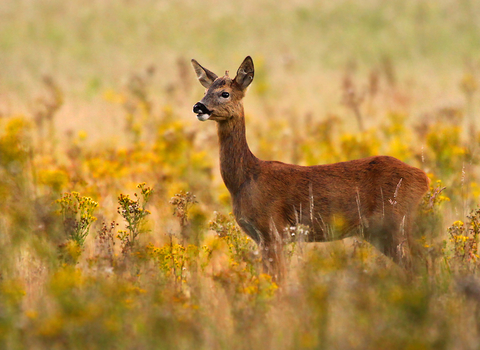
Roe deer ©Jon Hawkins - Surrey Hills Photography
Roe deer
The attractive roe deer is native to the UK and widespread across woodland, farmland, grassland and heathland habitats. Look for its distinctive pale rump and short antlers.
Scientific name
Capreolus capreolusWhen to see
January to DecemberSpecies information
About
Our most common native deer, the roe deer tends to be solitary in summer, but forms small, loose groups in winter. The males have relatively short antlers, typically with three points. They begin to grow their antlers in November, shedding the velvet from them in the spring. By summer, they are ready for the rutting season. After mating, they shed their antlers in October and begin to grow a new set.Roe deer live in areas of mixed countryside that includes woodland, farmland, grassland and heathland. They eat buds and leaves from trees and shrubs, as well as ferns, grasses and heathers.
How to identify
A slender, medium-sized deer, the roe deer has short antlers and no tail. It is mostly brown in colour, turning reddish in the summer and darker grey in the winter. It has a pale buff patch around its rump.Distribution
Widespread in Scotland and England. Scarce in Wales, the Midlands and southern England. Absent from Northern Ireland.In our area
Roe deer are common in Shropshire and can be found wandering in woodlands all over the county. They have been spotted at Earl's and Pontesford Hill.
Did you know?
A male roe deer is called a 'buck' and the female is a 'doe'. Mating occurs in July and August, but females delay implantation of the fertilised egg until January of the following year, so that the young are not born during the harsh winter months. Two or three, white-spotted kids are born in May or June.Watch
Roe deer (https://vimeo.com/642273440)
John Bridges
Roe deer are common in Shropshire and can be found wandering in woodlands all over the county. They have been spotted at Earl's and Pontesford Hill.

